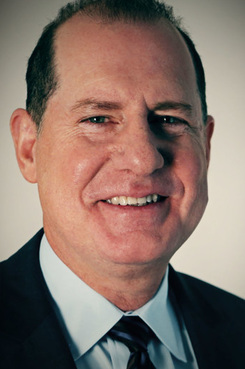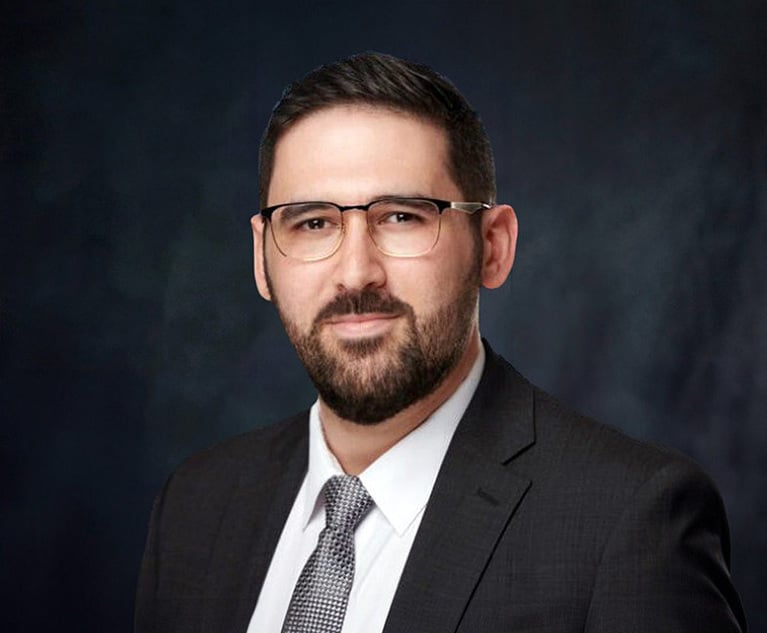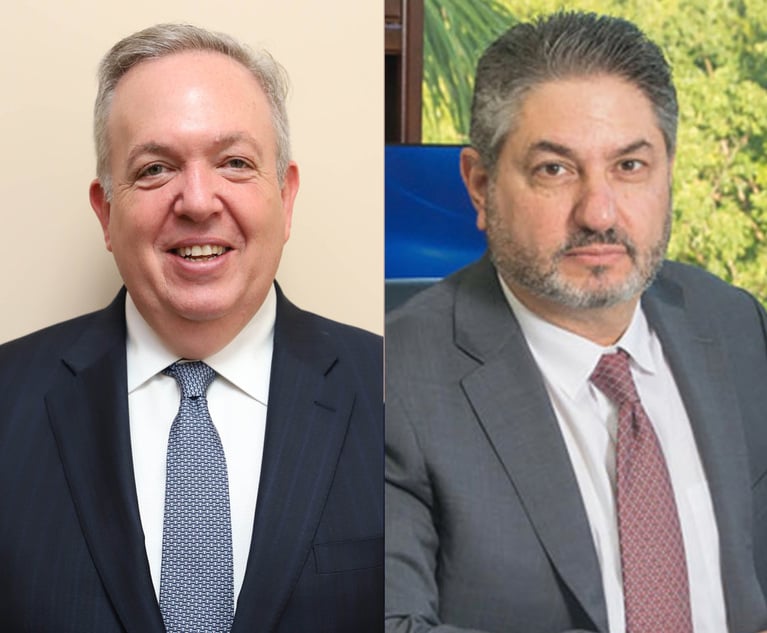The 'Frye' Standard Is the Law in Fla., 'a Monumental Game Changer'
In a crucial 4-3 decision, in Delisle v. Crane, Case (No. SC16-2182) (Oct 15. 2018), the Florida Supreme Court has clarified the law governing the admissibility of expert witness testimony in Florida—moving away from the Daubert standard utilized in federal courts, to the Frye standard.
October 23, 2018 at 09:30 AM
4 minute read
 David Haber, with Haber Slade.
David Haber, with Haber Slade.In a crucial 4-3 decision, in Delisle v. Crane, Case (No. SC16-2182) (Oct 15. 2018), the Florida Supreme Court has clarified the law governing the admissibility of expert witness testimony in Florida—moving away from the Daubert standard utilized in federal courts, to the Frye standard. Prior to Delisle, Florida courts were unsure whether to analyze expert testimony and corresponding pretrial motions under Daubert or Frye, so most trial courts utilized Daubert.
This confusion arose in 2013 when the Florida Legislature passed legislation modifying Florida Statute Section 90.702 to adopt the Daubert standard, despite the Florida Supreme Court's repeated affirmations of Frye. Delisle held that the Legislature overstepped its authority when it adopted Daubert, because the manner in which trials and litigation are to be conducted are “procedural” matters—which are entirely within the province of the Florida Supreme Court under Article V, Section 2(a) of the Florida Constitution.
Delisle will have a profound impact on litigation in Florida. The strategy of moving to strike expert testimony, a tactic long embraced by defendants, will be more difficult. For large construction cases, especially Chapter 558 lawsuits relating to high-rise condominiums, Delisle will likely save plaintiffs vast sums of money. Additional rounds of destructive testing or investigation that may have been required under Daubert will likely no longer be necessary. Under the Frye standard, a plaintiff must demonstrate that its expert is using methods that are “generally accepted” by the community of similarly situated professionals. Under Daubert, the expert's methods must be “scientifically reliable” and based on literature. In order to satisfy Daubert, most trial judges required plaintiffs to overcome the substantial hurdles of testing methodologies, statistical probabilities, and margins of error. As the court stated in Delisle: “Frye relies on the scientific community to determine reliability, whereas Daubert relies on the scientific savvy of trial judges to determine the significance of the methodology used.”
In a concurring opinion, Justice Barbara Pariente explained that the Daubert amendment to Section 90.702 had “the potential to unconstitutionally impair civil litigants' right to access to the courts.” Pariente explained that “defendants often exploit the requirements of Daubert as a sword against plaintiffs attorneys.” In addition, she acknowledged that Daubert hearings, which were in essence mini-trials, produced a “minefield clogged” with pretrial hearings that were “lengthy, technical and diffuse.”
To overcome a Daubert challenge, a plaintiff with a significant construction defect claim typically had to: hire an expert statistician to determine how much testing is required and at which locations to test; comply with the statistician's methodology for where to test, necessitating a significant percentage of the building being tested at great expense; and overcome the methodology challenges of the defendants in countless Daubert motions. The testing costs, and addressing as many as 25 to 50 defense Daubert motions seeking to exclude multiple experts from testifying (and the corresponding multiple day-long evidentiary hearings) caused tremendous hardship to plaintiffs. Costs and legal fees increased by hundreds of thousands of dollars, and in some cases in excess of $1 million. This scenario often forced plaintiffs to abandon their claims or settle for less money due to these financial pressures. Defendants and their insurance carriers consistently utilized these litigation strategies to grind down plaintiffs and force them to accept lower settlements prior to trial.
In construction cases in particular, insurance carriers providing a defense to developers, contractors, architects, engineers and manufacturers often waited until the outcome of the Daubert hearings before analyzing the true value of the case—since there was a significant possibility of striking the expert testimony supporting the plaintiff's claims. Therefore, Delisle is a monumental game changer, especially in large multi-party construction cases. It alters the balance of power between plaintiffs and defendants, and levels the playing field.
In my opinion, Delisle was correctly decided. The court recognized the disparity of power, the inherent unfairness, and burden that Daubert placed upon plaintiffs. The court acknowledged that juries are capable of evaluating the credibility of competing expert testimony in making their decision and that trial judges should not usurp the jury's role. As a plaintiff's counsel in high-rise condominium construction cases, I have seen firsthand the crippling financial impact of Daubert upon plaintiffs. The lethal weapon of Daubert has been neutralized. Plaintiffs can wave goodbye to Daubert, strengthening their chances of success in dealing with the defendants and their deep-pocket insurance carriers.
David B. Haber is the managing partner of Haber Slade. His practice areas include construction and condominium and homeowner association law, as well as complex commercial and real estate litigation. He can be reached at [email protected].
This content has been archived. It is available through our partners, LexisNexis® and Bloomberg Law.
To view this content, please continue to their sites.
Not a Lexis Subscriber?
Subscribe Now
Not a Bloomberg Law Subscriber?
Subscribe Now
NOT FOR REPRINT
© 2025 ALM Global, LLC, All Rights Reserved. Request academic re-use from www.copyright.com. All other uses, submit a request to [email protected]. For more information visit Asset & Logo Licensing.
You Might Like
View All
Conversation Catalyst: Transforming Professional Advancement Through Strategic Dialogue
5 minute read
SEC Whistleblower Program: What to Expect Under the Trump Administration
6 minute read
Turning the Shock of a January Marital Split Into Effective Strategies for Your Well-Being
5 minute read
Trending Stories
- 1States Accuse Trump of Thwarting Court's Funding Restoration Order
- 2Microsoft Becomes Latest Tech Company to Face Claims of Stealing Marketing Commissions From Influencers
- 3Coral Gables Attorney Busted for Stalking Lawyer
- 4Trump's DOJ Delays Releasing Jan. 6 FBI Agents List Under Consent Order
- 5Securities Report Says That 2024 Settlements Passed a Total of $5.2B
Who Got The Work
J. Brugh Lower of Gibbons has entered an appearance for industrial equipment supplier Devco Corporation in a pending trademark infringement lawsuit. The suit, accusing the defendant of selling knock-off Graco products, was filed Dec. 18 in New Jersey District Court by Rivkin Radler on behalf of Graco Inc. and Graco Minnesota. The case, assigned to U.S. District Judge Zahid N. Quraishi, is 3:24-cv-11294, Graco Inc. et al v. Devco Corporation.
Who Got The Work
Rebecca Maller-Stein and Kent A. Yalowitz of Arnold & Porter Kaye Scholer have entered their appearances for Hanaco Venture Capital and its executives, Lior Prosor and David Frankel, in a pending securities lawsuit. The action, filed on Dec. 24 in New York Southern District Court by Zell, Aron & Co. on behalf of Goldeneye Advisors, accuses the defendants of negligently and fraudulently managing the plaintiff's $1 million investment. The case, assigned to U.S. District Judge Vernon S. Broderick, is 1:24-cv-09918, Goldeneye Advisors, LLC v. Hanaco Venture Capital, Ltd. et al.
Who Got The Work
Attorneys from A&O Shearman has stepped in as defense counsel for Toronto-Dominion Bank and other defendants in a pending securities class action. The suit, filed Dec. 11 in New York Southern District Court by Bleichmar Fonti & Auld, accuses the defendants of concealing the bank's 'pervasive' deficiencies in regards to its compliance with the Bank Secrecy Act and the quality of its anti-money laundering controls. The case, assigned to U.S. District Judge Arun Subramanian, is 1:24-cv-09445, Gonzalez v. The Toronto-Dominion Bank et al.
Who Got The Work
Crown Castle International, a Pennsylvania company providing shared communications infrastructure, has turned to Luke D. Wolf of Gordon Rees Scully Mansukhani to fend off a pending breach-of-contract lawsuit. The court action, filed Nov. 25 in Michigan Eastern District Court by Hooper Hathaway PC on behalf of The Town Residences LLC, accuses Crown Castle of failing to transfer approximately $30,000 in utility payments from T-Mobile in breach of a roof-top lease and assignment agreement. The case, assigned to U.S. District Judge Susan K. Declercq, is 2:24-cv-13131, The Town Residences LLC v. T-Mobile US, Inc. et al.
Who Got The Work
Wilfred P. Coronato and Daniel M. Schwartz of McCarter & English have stepped in as defense counsel to Electrolux Home Products Inc. in a pending product liability lawsuit. The court action, filed Nov. 26 in New York Eastern District Court by Poulos Lopiccolo PC and Nagel Rice LLP on behalf of David Stern, alleges that the defendant's refrigerators’ drawers and shelving repeatedly break and fall apart within months after purchase. The case, assigned to U.S. District Judge Joan M. Azrack, is 2:24-cv-08204, Stern v. Electrolux Home Products, Inc.
Featured Firms
Law Offices of Gary Martin Hays & Associates, P.C.
(470) 294-1674
Law Offices of Mark E. Salomone
(857) 444-6468
Smith & Hassler
(713) 739-1250






